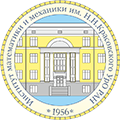A PAIR OF FOUR-ELEMENT HORIZONTAL GENERATING SETS OF A PARTITION LATTICE
Abstract
Let \(\lfloor x \rfloor\) and \(\lceil x\rceil \) denote the lower integer part and the upper integer part of a real number \(x\), respectively. Our main goal is to construct four partitions of a finite set \(A\) with \(n\geq 7\) elements such that each of the four partitions has exactly \(\lceil n/2\rceil \) blocks and any other partition of \(A\) can be obtained from the given four by forming joins and meets in a finite number of steps. We do the same with \(\lceil n/2\rceil-1\) instead of \(\lceil n/2\rceil\), too. To situate the paper within lattice theory, recall that the partition lattice \(\mathrm{Eq}(A)\) of a set \(A\) consists of all partitions (equivalently, of all equivalence relations) of \(A\). For a natural number \(n\), \([n]\) and \(\mathrm{Eq}(n)\) will stand for \(\{1,2,\dots,n\}\) and \(\mathrm{Eq}([n])\), respectively. In 1975, Heinrich Strietz proved that, for any natural number \(n\geq 3\), \(\mathrm{Eq} (n)\) has a four-element generating set; half a dozen papers have been devoted to four-element generating sets of partition lattices since then. We give a simple proof of his just-mentioned result. We call a generating set \(X\) of \(\mathrm{Eq}(n)\) horizontal if each member of \(X\) has the same height, denoted by \(h(X)\), in \(\mathrm{Eq} (n)\); no such generating sets have been known previously. We prove that for each natural number \(n\ge 4\), \(\mathrm{Eq}(n)\) has two four-element horizontal generating sets \(X\) and \(Y\) such that \(h(Y)=h(X) +1\); for \(n\geq 7\), \(h(X)= \lfloor n/2 \rfloor\).
Keywords
Full Text:
PDFReferences
- Czédli G. Lattices embeddable in three-generated lattices. Acta Sci. Math. (Szeged), 2016. Vol. 82. P. 361–382. DOI: 10.14232/actasm-015-586-2
- Czédli G. Generating Boolean lattices by few elements and exchanging session keys. Novi Sad J. Math., 2025. Published online ahead of print October 8, 2024. DOI: 10.30755/NSJOM.16637
- Czédli G. Four generators of an equivalence lattice with consecutive block counts. In: Model Theory and Algebra 2024: collection of papers. M. Shahryari, S.V. Sudoplatov (eds.). Novosibirsk: Novosibirsk State Univ., 2024. P. 14–24. URL: https://erlagol.ru/wp-content/uploads/cbor/erlagol 2024.pdf
- Czédli G. Atoms in four-element generating sets of partition lattices. Math. Pannonica, 2025. Vol. 31 NS5, No. 1. P. 88–96. DOI: 10.1556/314.2025.00010
- Czédli G., Kurusa Á. A convex combinatorial property of compact sets in the plane and its roots in lattice theory. Categ. Gen. Algebr. Struct. Appl., 2019. Vol. 11. P 57–92. DOI: 10.29252/CGASA.11.1.57
- Czédli G., Oluoch L. Four-element generating sets of partition lattices and their direct products. Acta Sci. Math. (Szeged), 2020. Vol. 86. P. 405–448. DOI: 10.14232/actasm-020-126-7
- Grätzer G. General Lattice Theory, 2nd. ed. Basel–Boston–Berlin: Birkhäuser, 1998. XX+663 p. ISBN: 978-3-7643-6996-5.
- Grätzer G. Lattice Theory: Foundation. Basel: Birkhäuser, 2011. XXX+614 p. DOI: 10.1007/978-3-0348-0018-1
- Pudlák P., Tůma J. Every finite lattice can be embedded in a finite partition lattice. Algebra Universalis, 1980. Vol. 10. P. 74–95. DOI: 10.1007/BF02482893
- Strietz H. Finite partition lattices are four-generated. In: Proc. Lattice Th. Conf. Ulm, 1975. P. 257–259.
- Strietz H. Über Erzeugendenmengen endlicher Partitionenverbände. Studia Sci. Math. Hungar., 1977. Vol. 12, No. 1–2. P. 1–17. (in German)
- Whitman P.M. Lattices, equivalence relations, and subgroups. Bull. Amer. Math. Soc., 1946. Vol. 52, No. 6. P. 507–522. DOI: 10.1090/S0002-9904-1946-08602-4
- Zádori L. Generation of finite partition lattices. In: Lectures in Universal Algebra: Proc. Colloq. (Szeged, 1983). Colloq. Math. Soc. János Bolyai, vol. 43. Amsterdam: North-Holland Publishing, 1986. P. 573–586.
Article Metrics
Refbacks
- There are currently no refbacks.













